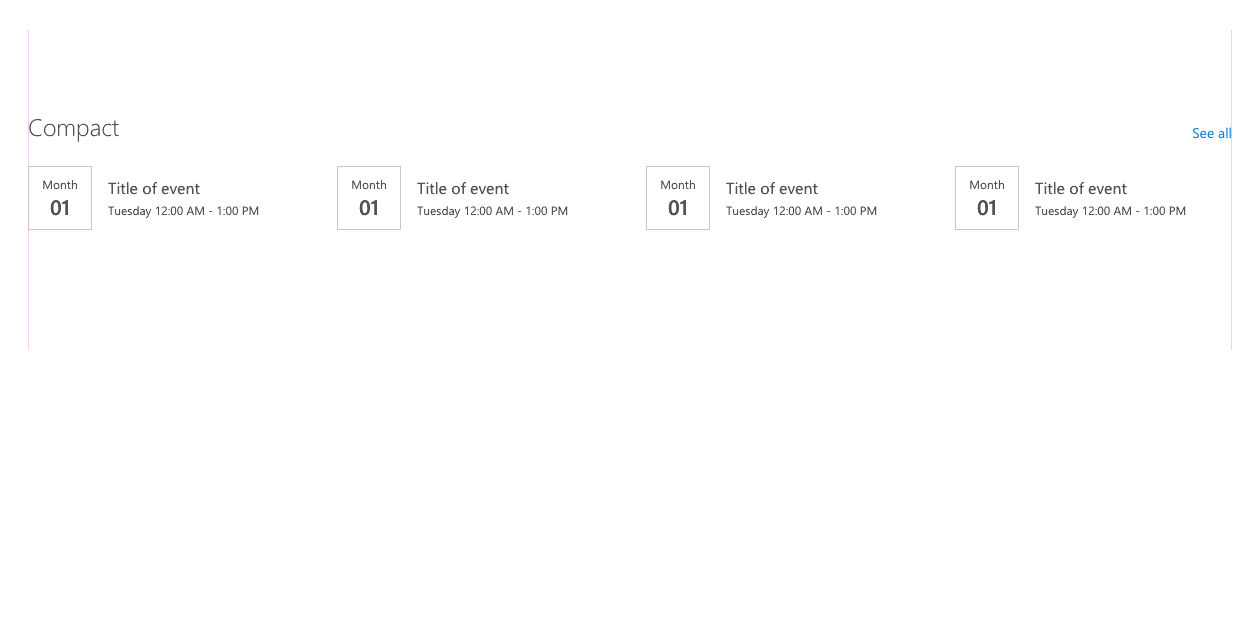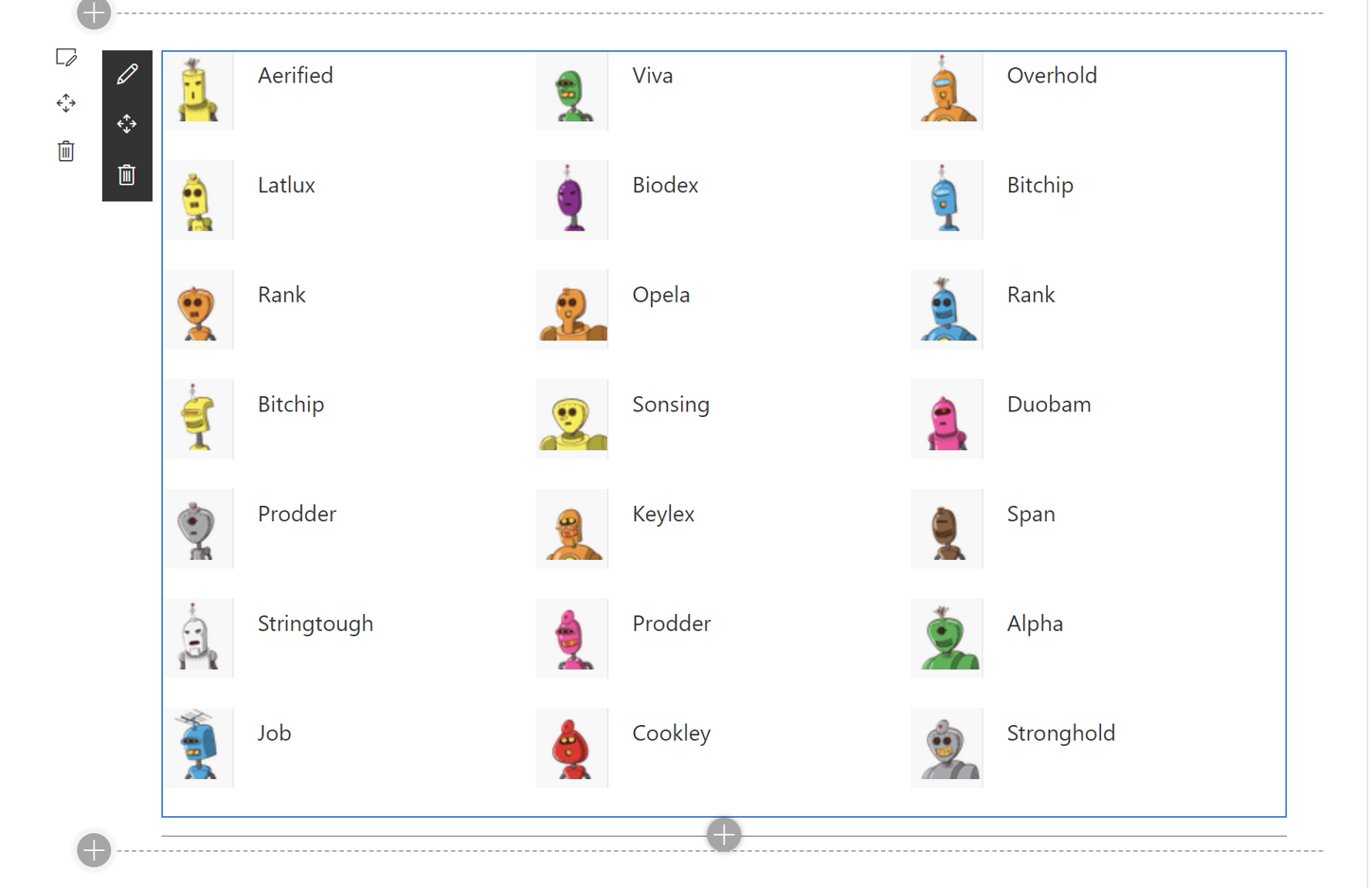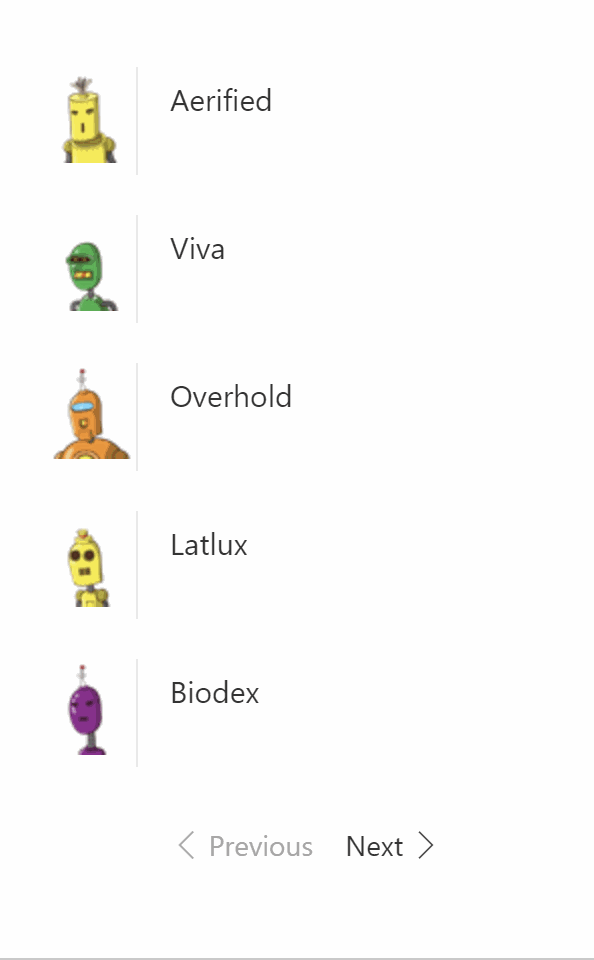


Microsoft has an awesome web site called SharePoint Design. It provides design guidance on beautiful and fast sites, pages, and web parts with SharePoint in Office 365.
However, it does not tell you how to create those beautiful web parts.
This blog series is intended as a companion to the SharePoint Design site. It provides code samples and detailed how-to information for every design topic.
It should help you create web parts that look exactly like the ones on the SharePoint Design site.
So far, we have discussed the following topics:
In today’s post, we’ll continue our discussion about the web part layout patterns and discuss the compact layout.

According to the SharePoint Design site:
The compact layout is designed to show content in a smaller format and works the best in a one-third column. This layout can support a small image or icon and a few rows of text for a title, description, and/or metadata.
However, it seems that the compact layout is not only used in 1/3 columns. The SharePoint look book and the SharePoint Online Provisioning Service both make use of the compact layout with the Quick Links web part.
Use the compact layout when the items in your web part have very little information. A title and an icon or a small thumbnail is pretty much all you’ll be able to fit it.
The compact layout is simply a Grid layout, but where the individual items use a compact document card layout instead of the full document card.
To create your own, you would use an Office UI Fabric List control and render each item inside the list with a DocumentCard control where the type of the DocumentCard control would be set to DocumentCardType.compact.
Or, you can simply use the component I built to make my life easier.
Note: The source code for this sample can be found in the WebPartLayouts sample on my repo.
Create your own web part solution. For this sample, we’ll assume that your web part is called CompactWebPart and that the component which renders the content of the web part is called Compact.
Copy the content of the src\components\compactLayout from my sample code to your own solution. You may need to create a components and compactLayout folder under src to do so.
In your web part, load the items you wish to display. For this example, we’ll set them in your web part’s state and hard-code them in your web part’s constructor, but feel free to load any data you want to use. We’ll want to have at least a title attribute and a thumbnail attribute, but — as you’ll see later — you can really display any information you want when you render each item.
constructor(props: ICompactProps) {
super(props);
// Sample data generated at https://mockaroo.com/
this.state = {
items: [{
thumbnail: "https://robohash.org/nostrumquiiure.png?size=48x48&set=set1",
title: "Aerified"
}, {
thumbnail: "https://robohash.org/minimafugitenim.png?size=48x48&set=set1",
title: "Viva"
}, {
thumbnail: "https://robohash.org/nihilbeataeculpa.png?size=48x48&set=set1",
title: "Overhold"
}, {
thumbnail: "https://robohash.org/essequiquo.png?size=48x48&set=set1",
title: "Latlux"
}, {
thumbnail: "https://robohash.org/inipsumtotam.png?size=48x48&set=set1",
title: "Biodex"
}, {
thumbnail: "https://robohash.org/utmodiet.png?size=48x48&set=set1",
title: "Bitchip"
}, {
thumbnail: "https://robohash.org/undeenimvel.png?size=48x48&set=set1",
title: "Rank"
}, {
thumbnail: "https://robohash.org/pariaturoditdolore.png?size=48x48&set=set1",
title: "Opela"
}, {
thumbnail: "https://robohash.org/nullaullamincidunt.png?size=48x48&set=set1",
title: "Rank"
}, {
thumbnail: "https://robohash.org/accusantiumnonvoluptatibus.png?size=48x48&set=set1",
title: "Bitchip"
}, {
thumbnail: "https://robohash.org/culpaeossapiente.png?size=48x48&set=set1",
title: "Sonsing"
}, {
thumbnail: "https://robohash.org/harumnihilvelit.png?size=48x48&set=set1",
title: "Duobam"
}, {
thumbnail: "https://robohash.org/quianesciuntet.png?size=48x48&set=set1",
title: "Prodder"
}, {
thumbnail: "https://robohash.org/aliquidipsamrem.png?size=48x48&set=set1",
title: "Keylex"
}, {
thumbnail: "https://robohash.org/dignissimoseosaccusamus.png?size=48x48&set=set1",
title: "Span"
}, {
thumbnail: "https://robohash.org/exomnisexcepturi.png?size=48x48&set=set1",
title: "Stringtough"
}, {
thumbnail: "https://robohash.org/occaecatimolestiaererum.png?size=48x48&set=set1",
title: "Prodder"
}, {
thumbnail: "https://robohash.org/consequaturinquis.png?size=48x48&set=set1",
title: "Alpha"
}, {
thumbnail: "https://robohash.org/sapienteofficiisest.png?size=48x48&set=set1",
title: "Job"
}, {
thumbnail: "https://robohash.org/similiquesuntiusto.png?size=48x48&set=set1",
title: "Cookley"
}, {
thumbnail: "https://robohash.org/sitnequequi.png?size=48x48&set=set1",
title: "Stronghold"
}]
};
}
In your web part’s component, add an import for the compactLayout. You’ll also need an import for the UI Fabric DocumentCard component:
// Used to render document cards
import {
DocumentCard,
DocumentCardPreview,
DocumentCardDetails,
DocumentCardTitle,
IDocumentCardPreviewProps,
DocumentCardType
} from 'office-ui-fabric-react/lib/DocumentCard';
import { ImageFit } from 'office-ui-fabric-react/lib/Image';
import CompactLayout from '../../../components/compactLayout/CompactLayout';
Add a _onRenderGridItem method:
private _onRenderGridItem = (item: any, _index: number): JSX.Element => {
const previewProps: IDocumentCardPreviewProps = {
previewImages: [
{
previewImageSrc: item.thumbnail,
imageFit: ImageFit.centerCover,
height: 48,
width: 48
}
]
};
return <div
data-is-focusable={true}
data-is-focus-item={true}
role="listitem"
aria-label={item.title}
>
<DocumentCard
type={DocumentCardType.compact}
onClick={(ev: React.SyntheticEvent<HTMLElement>) => alert(ev)}
>
<DocumentCardPreview {...previewProps} />
<DocumentCardDetails>
<DocumentCardTitle
title={item.title}
shouldTruncate={true}
/>
</DocumentCardDetails>
</DocumentCard>
</div>;
}
}
Update your component’s render method to render the compact layout as follows:
public render(): React.ReactElement<ICompactProps> {
return (
<div className={styles.compact}>
<CompactLayout
items={this.state.items}
onRenderGridItem={(item: any, index: number) => this._onRenderGridItem(item, index)}
/>
</div>
);
}
That’s really all there is to it! You web part will render something like this:
The great thing is that it is entirely up to you how you want to render each item. I chose to use the DocumentCard control, but you can replace any part of your _onRenderGridItem method to suit your needs.
For example, if you wanted to render a date instead of an thumbnail, you could use something like the DateBox component that I wrote for the React Calendar Feed sample.

When I first built the React Calendar Feed sample, the Events web part showed little Previous and Next buttons at the bottom of the web part when displaying in the compact mode.
It seems that the pagination has since been removed from the standard web part design. Nevertheless, I have included a sample control to show how you can add pagination to your compact web part.
Use it at your discretion.
To add pagination to your web part, follow these steps:
Copy the content of the src\components\paging from my sample code to your own solution. You may need to create a paging folder under src\components to do so.
Add a variable to store the current page number in your component’s state, as follows:
export interface ICompactState {
items: any[];
currentPage: number;
}
In your component’s constructor, set the current page to 1, as follows:
constructor(props: ICompactProps) {
super(props);
// Sample data generated at https://mockaroo.com/
this.state = {
currentPage: 1,
items: [{
thumbnail: "https://robohash.org/nostrumquiiure.png?size=48x48&set=set1",
title: "Aerified"
}, {
thumbnail: "https://robohash.org/minimafugitenim.png?size=48x48&set=set1",
title: "Viva"
}, {
thumbnail: "https://robohash.org/nihilbeataeculpa.png?size=48x48&set=set1",
title: "Overhold"
}, {
thumbnail: "https://robohash.org/essequiquo.png?size=48x48&set=set1",
title: "Latlux"
}, {
thumbnail: "https://robohash.org/inipsumtotam.png?size=48x48&set=set1",
title: "Biodex"
}, {
thumbnail: "https://robohash.org/utmodiet.png?size=48x48&set=set1",
title: "Bitchip"
}, {
thumbnail: "https://robohash.org/undeenimvel.png?size=48x48&set=set1",
title: "Rank"
}, {
thumbnail: "https://robohash.org/pariaturoditdolore.png?size=48x48&set=set1",
title: "Opela"
}, {
thumbnail: "https://robohash.org/nullaullamincidunt.png?size=48x48&set=set1",
title: "Rank"
}, {
thumbnail: "https://robohash.org/accusantiumnonvoluptatibus.png?size=48x48&set=set1",
title: "Bitchip"
}, {
thumbnail: "https://robohash.org/culpaeossapiente.png?size=48x48&set=set1",
title: "Sonsing"
}, {
thumbnail: "https://robohash.org/harumnihilvelit.png?size=48x48&set=set1",
title: "Duobam"
}, {
thumbnail: "https://robohash.org/quianesciuntet.png?size=48x48&set=set1",
title: "Prodder"
}, {
thumbnail: "https://robohash.org/aliquidipsamrem.png?size=48x48&set=set1",
title: "Keylex"
}, {
thumbnail: "https://robohash.org/dignissimoseosaccusamus.png?size=48x48&set=set1",
title: "Span"
}, {
thumbnail: "https://robohash.org/exomnisexcepturi.png?size=48x48&set=set1",
title: "Stringtough"
}, {
thumbnail: "https://robohash.org/occaecatimolestiaererum.png?size=48x48&set=set1",
title: "Prodder"
}, {
thumbnail: "https://robohash.org/consequaturinquis.png?size=48x48&set=set1",
title: "Alpha"
}, {
thumbnail: "https://robohash.org/sapienteofficiisest.png?size=48x48&set=set1",
title: "Job"
}, {
thumbnail: "https://robohash.org/similiquesuntiusto.png?size=48x48&set=set1",
title: "Cookley"
}, {
thumbnail: "https://robohash.org/sitnequequi.png?size=48x48&set=set1",
title: "Stronghold"
}]
};
}
Add an import for the paging component at the top of your file:
import { Paging } from '../../../components/paging';
Change your render method to get a subset of items to show, as follows:
public render(): React.ReactElement<ICompactProps> {
let pagedItems: any[] = this.state.items;
const totalItems: number = pagedItems.length;
let showPages: boolean = false;
const maxEvents: number = 5; // Use any page size you want
const { currentPage } = this.state;
if (true && totalItems > 0 && totalItems > maxEvents) {
// calculate the page size
const pageStartAt: number = maxEvents * (currentPage - 1);
const pageEndAt: number = (maxEvents * currentPage);
pagedItems = pagedItems.slice(pageStartAt, pageEndAt);
showPages = true;
}
return (
<div className={styles.compact}>
<CompactLayout
items={pagedItems}
onRenderGridItem={(item: any, index: number) => this._onRenderGridItem(item, index)} />
{showPages &&
<Paging
showPageNumber={true}
currentPage={currentPage}
itemsCountPerPage={maxEvents}
totalItems={totalItems}
onPageUpdate={this._onPageUpdate}
nextButtonLabel={strings.NextLabel}
previousButtonLabel={strings.PreviousLabel}
/>
}
</div>
);
}
Finally, add a method to store the current page number in your state every time the page changes, as follows:
private _onPageUpdate = (pageNumber: number): void => {
this.setState({
currentPage: pageNumber
});
}
Test your web part. You should now get a next and previous buttons at bottom of your web part.

The compact layout is simply a grid control which renders compact document cards.
In our next post, we’ll discuss the list layout!